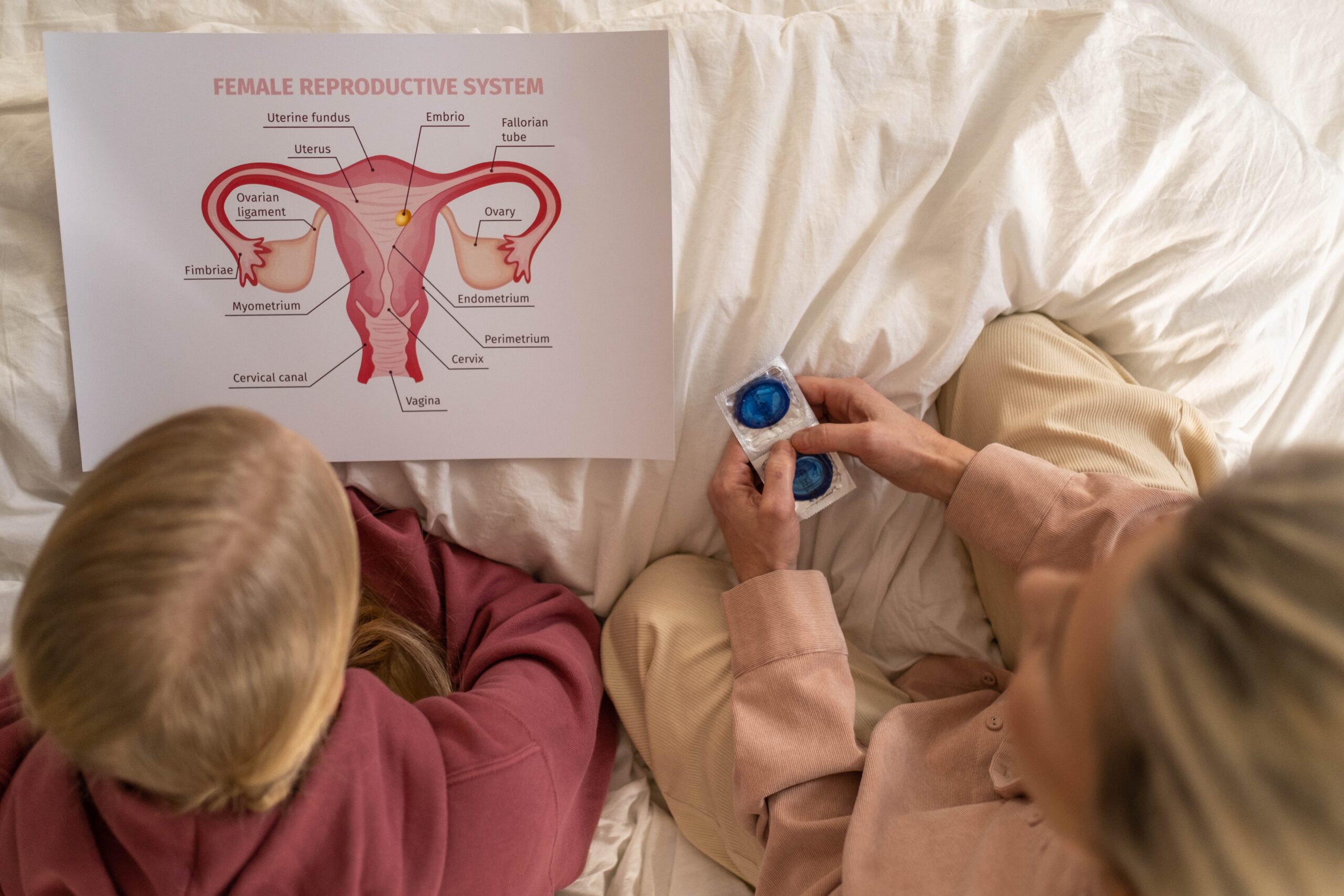
An adolescent being taught about sexual education. (Photo by: cottonbro, Pexels)
Louisiana did not permit sex education until 1979, and the policies from then are the same policies that are currently in place today if the school, that is, chooses to teach sex ed seeing as Louisiana schools are not required to.
The Louisiana Revised Statute does, however, require that students take half a credit of health during which they learn about sexual risk behaviors, HIV/AIDS, and other STDs. The individual parish’s (districts) school boards decide whether or not they will offer sex education, and if they do there are certain things they have to teach and other things that are not allowed. Louisiana school’s sex education classes cannot be offered until after 6th grade, but are required at any age if the student becomes pregnant. The Louisiana curriculum is not required to be comprehensive and forbids instructors from teaching about male or female homosexual activity, advocating for abortion, and are not required to include instruction on consent. Since sex education is not considered essential in Louisiana, through an “opt-out” policy, parents may remove their child from the sex education unit of class and they are given other work to do. The main way that students are taught to avoid STDs and pregnancy is by staying abstinent, in fact this is something that teachers are required to heavily emphasize when teaching. In schools where sex education is offered, it is also necessary for the course to be taught during an existing class such as a science or physical education class. As with most courses the teacher must not include religious beliefs or their own judgements while teaching, and are required to teach based on factual information.
Upon looking at the state’s statistics for teen pregnancy and STD rates, it is not hard to see that the guidelines and restrictions that the Louisiana state legislation has in place are not enough in educating students on how to have safe sex. Louisiana ranks in the top five in the nation for both STD and teen pregnancy rates. Falling at third highest in the nation for teen pregnancy with a birth rate of 27.8 births per 1,000 women, with 18% of teen mothers having already had a child, it is revealed that teaching abstinence as the solution to teen pregnancy is not enough. A staggering number of pregnancies in Louisiana in general are described by women as unplanned at 60%. Louisiana falls at third in the nation again with STI cases. With 1,046 STI cases per 100,000 people (774.8 being chlamydia and 257.1 being gonorrhea) there is a glaringly obvious issue with the state’s prevention tactics. The lack of required sex education and a comprehensive curriculum in a place where parents do not teach their children about safe sex is extremely dangerous.
Teen pregnancy, as prevalent as it is in Louisiana, is extremely detrimental to teen mother’s futures.

Positive pregnancy test. (Photo by: Nataliya Vaitkevich, Pexels)
There is a direct correlation between education level and a person’s potential income. High school dropouts have the lowest potential to earn decent money, and 40% of pregnant teens do not finish high school. Teenagers who do not finish high school are more likely to live in poverty and will be passed over for jobs when compared to women who have college degrees of any sort. This does not help with poverty rates for single teen moms considering that in the last 20 years, the average income has increased by 19% for college graduates, while the average income for high school dropouts has decreased by 28%. In the United States, 60% of those in poverty are young single moms, and in New Orleans the rate for single moms in poverty is 72.6%. With New Orleans’ total poverty rate falling at 25.4%, there is an exceptional rate of single teen moms in poverty, this rate could decrease significantly with comprehensive sex education and other preventative programs.
Recent leaks from the Supreme Court have revealed that Roe v. Wade is likely to be overturned. Roe v. Wade was a Supreme Court ruling that states that the Constitution of the United States protects a woman’s right to choose whether or not to have an abortion. If this actually happens, the legality of abortion (among other things) will be up to each state. Currently in Louisiana, there are only 3 clinics that provide abortion. The main rulings at present are that a woman my obtain an abortion up to 20 weeks, abortion may only be performed after 20 weeks if the woman or fetus’ life is in danger, and that unmarried teens are required to have permission from a guardian or judge in order to obtain an abortion. The process is not easy either, with counseling to try to convince the patient to keep the child. If Roe v. Wade is overturned, these limited rights to bodily autonomy will disappear. Louisiana has a trigger ban, near-total ban, six-week ban, and the state constitution fails to protect abortion rights if this ruling happens. If these restrictions go in place, Louisiana needs to focus on reforming its sex education so teenagers do not perform unsafe abortions. The big question at the moment is how to do that in the correct way?
Part II: The Solution
In order to try to find a solution to this problem, I decided to look at the rankings and statistics lists I had found for Louisiana’s information on teen pregnancy and STI rates and find the state that on average had the lowest numbers all around. After I found the state, I would look into their sex education curriculum and other sex education programs outside of schools to establish a new plan for Louisiana to follow. The state with the lowest numbers on average was Vermont. Vermont’s chlamydia rate is the second-lowest in the country at 274.5 cases per 100,000, and the gonorrhea and syphilis rates are the lowest in the country at 43 cases per 100,000 people and 1.8 cases per 100,000 people, respectively. Vermont also has extremely low teen/unplanned pregnancy rates with only 7 births per 1,000 teens and 46% of women describing their pregnancies as unplanned.
From the starting point of Vermont’s low numbers, I began to look into their sexual health education curriculum. This curriculum is comprehensive and addresses topics such as: healthy relationships, consent, LGBTQ education, HIV/AIDS and Sexually Transmitted Infection (STI) education, and sexual violence prevention. The agency of education in Vermont claims responsibility for increasing sexual health awareness in students in order to maintain students well-being and academic success. The topics in Vermont’s curriculum are slightly similar to Louisiana’s, but there are many others that are not even thought of in Louisiana’s curriculum. LGBTQ education, consent, and sexual violence prevention are extremely important topics, and Louisiana either prohibits them or does not teach them. These programs are essential to having safe sex no matter how a person identifies. Vermont places emphasis on all of the different methods of birth control and STI prevention, not just abstinence like Louisiana. As of July 1, 2021, Vermont adopted a new provision through which they strive to encourage teenagers to safely have sex if they are going to do it. This program is the Condom Availability program. Vermont enacted this provision to prevent and reduce teen pregnancies and STIs in its high schoolers by having readily available condoms in locations that are safe and easily accessible to students.
Another location that implemented a Condom Availability Program was New York City, which had a problem with STIs. With this program, students in high school were able to go to their school’s health resource room to ask for free condoms, information about HIV/AIDs, information about sexual health topics, referrals to health services, and information about getting tested for STIs. This program proved to be effective, with a 13% increase in condom use from 2015 to 2017 in NYC Public High Schools. It also had no increase in rates of sexual activity, and lowered rates of STD and HIV transmission.

Condoms on a table. (Photo by: Klaus Nielsen, Pexels)
Comprehensive sex education is proven to reduce teen pregnancy. In a study done by the University of Washington, it was found that adolescents who receive comprehensive sex education are much less likely to get pregnant in comparison to teens who receive abstinence only sex education. Teaching methods and skills to prevent pregnancy and STI transmission in schools is essential, especially because different methods of sex education do not stop teenagers from having sex. Abstinence-only sex education teens have sex at the same rates as teenagers who receive a comprehensive sex education, they just do not know how to actually prevent pregnancy and STI transmission, so they are more likely to develop both.
Part III: The Implementation
New Orleans’ sex education is failing its people in many ways. Louisiana is one of the states with the highest STI and teen pregnancy rates. In a place where sexual health is not prioritized and abortion is soon to be illegal, it is essential that New Orleans change its sex education to be required everywhere and be more comprehensive. By modeling a new comprehensive curriculum after that of Vermont’s sex education curriculum, STI and teen pregnancy rates will decrease. Since sex education is not required in every school in Louisiana, making it required in all schools would be the first step in educating teenagers. The first step to implementing this would be revising the Statute to require that schools offer sex education. In New Orleans, most schools are a part of the charter system. The curriculum is set by the government and is required to be taught. The federal and state government need to implement the changes surrounding sex education since they are the ones who fund the charter/public schools.
Once this is passed, the legislature can focus on changing the curriculum to be comprehensive. In the new Statute the government will include the many different aspects that Vermont has in its curriculum. It will still allow for an opt-out option from parents, since that could be a reason that the legislature may not pass. In these changes, policy makers will include health related issues such as: consent, healthy relationships, condom education, sexual violence prevention, LGBTQ education, and Sexually Transmitted Infection (STI) education. Since currently, Louisiana’s sexual education requires that abstinence is the only prevention method emphasized, it is necessary that the curriculum is tailored to teach all of the ways to prevent teen pregnancy and STI transmission.
After the implementation of a comprehensive sex education program, other steps should also be taken to further educate about and prevent unsafe sex. One step would be a creating center where teens can sign up to take a class for sex education for free. This would allow teenagers in private schools that do not have a required sex education curriculum to go and obtain a comprehensive sex education. Vermont did this and actually paid teenagers to go, this incentive gave far more teens a more in-depth sex education course.
The final step would be to implement a Condom Availability Program in all secondary schools so that teenagers have access to a way to have safe sex that is not abstinence. Currently Louisiana schools are prohibited from handing out any contraceptive products, which prevents students from being taught how to put condoms on and limits places for them to obtain protection. This program would help to educate students about safer sex and provide a form of contraception for students who decide that they do not want to be abstinent.
These steps would work because education is a powerful thing. They have proven effective in other states like Vermont and large cities such as New York City and there is no reason that they would not succeed in New Orleans. Often people get STIs or get pregnant because they do not know how to prevent these things. By employing these changes the next generation will learn about sexual health and (like in Vermont) most would use these methods in their everyday lives and rates would go down.
Works Cited
“Abortion Restrictions: Lift Louisiana.” Abortion Restrictions | Lift Louisiana, https://liftlouisiana.org/issues/abortion-restrictions.
Bright, Marshall. “Study Finds That Comprehensive Sex Education Reduces Teen Pregnancy.” American Civil Liberties Union, American Civil Liberties Union, 17 Feb. 2012, https://www.aclu.org/blog/reproductive-freedom/study-finds-comprehensive-sex-education-reduces-teen-pregnancy.
Condom Availability Program – Web. https://www.schools.nyc.gov/school-life/health-and-wellness/condom-availability-program.
Gaille, Louise. “Teen Pregnancy and Poverty.” Vittana.org, 15 Jan. 2017, https://vittana.org/teen-pregnancy-and-poverty.
Guttmacher, Sally, et al. “Condom Availability in New York City Public High Schools: Relationships to Condom Use and Sexual Behavior.” NYU Scholars, American Public Health Association Inc., 26 Mar. 2020, https://nyuscholars.nyu.edu/en/publications/condom-availability-in-new-york-city-public-high-schools-relation.
“Increasing Condom Use with a CONDOM AVAILABILITY PROGRAM.” Centers for Disease Control and Prevention, Centers for Disease Control and Prevention, 4 Oct. 2019, https://www.cdc.gov/healthyyouth/stories/NY_condom.htm#:~:text=Increasing%20Condom%20Use%20with%20a%20Condom%20Availability%20Program,students%20by%2013%25%20in%2021%20select%20high%20schools.
“Louisiana Data.” Louisiana Data | Power to Decide, https://powertodecide.org/what-we-do/information/national-state-data/louisiana.
Louisiana, https://sexeducationcollaborative.org/states/louisiana.
Nash, Elizabeth, et al. “26 States Are Certain or Likely to Ban Abortion without Roe: Here’s Which Ones and Why.” Guttmacher Institute, 21 Apr. 2022, https://www.guttmacher.org/article/2021/10/26-states-are-certain-or-likely-ban-abortion-without-roe-heres-which-ones-and-why.
“New Orleans, Louisiana (LA) Poverty Rate Datainformation about Poor and Low-Income Residents.” New Orleans, Louisiana (LA) Poverty Rate Data – Information about Poor and Low-Income Residents Living in This City, https://www.city-data.com/poverty/poverty-New-Orleans-Louisiana.html.
Parenthood, Planned. “Louisiana Abortion Laws.” Planned Parenthood Center for Choice, https://www.plannedparenthood.org/planned-parenthood-center-for-choice/louisiana-abortion-laws.
“Poverty in New Orleans, Louisiana.” 25.4% Poverty Rate in New Orleans, Louisiana, https://www.welfareinfo.org/poverty-rate/louisiana/new-orleans.
“Roe v. Wade.” Wikipedia, Wikimedia Foundation, 7 May 2022, https://en.wikipedia.org/wiki/Roe_v._Wade.
“Sex Education in Louisiana.” Wikipedia, Wikimedia Foundation, 1 Aug. 2021, https://en.wikipedia.org/wiki/Sex_education_in_Louisiana#cite_note-3.
“Sexual Health.” Sexual Health | Agency of Education, https://education.vermont.gov/student-support/healthy-and-safe-schools/sexual-health.
Staff, ModernMom, and About ModernMom Staff. “How Teen Pregnancy Affects Job Opportunities.” ModernMom, 3 Sept. 2014, https://www.modernmom.com/2c6565e2-051f-11e2-9d62-404062497d7e.html.
STD Rates by State 2022, https://worldpopulationreview.com/state-rankings/std-rates-by-state.
“STD Rates by State: Where Chlamydia, Gonorrhea, and Syphilis Are Highest and Lowest – Blog: Everlywell: Home Health Testing Made Easy.” Everlywell, https://www.everlywell.com/blog/sti-testing/std-rates-by-state/.
Teen Pregnancy Rates by State 2022, https://worldpopulationreview.com/state-rankings/teen-pregnancy-rates-by-state.
“Vermont Data.” Vermont Data | Power to Decide, https://powertodecide.org/what-we-do/information/national-state-data/vermont.
 Digital Civic Engagement Spring 2024: Water & Wellness in New Orleans: A health crisis overlooked: HIV/AIDS in New Orleans
Tye Collins outlines the history of HIV/AIDS in New Orleans, and how this issue has followed suit of former racialized inequalities to predispose people of color to contract these diseases.
Digital Civic Engagement Spring 2024: Water & Wellness in New Orleans: A health crisis overlooked: HIV/AIDS in New Orleans
Tye Collins outlines the history of HIV/AIDS in New Orleans, and how this issue has followed suit of former racialized inequalities to predispose people of color to contract these diseases.
 Water and Wellness in New Orleans: Ports, cocktails, and medicine
Brett McSherry explains how the medicine of 1841 combined with the use of the Port of New Orleans created the first cocktail. Sipping medicine has a whole new meaning now.
Water and Wellness in New Orleans: Ports, cocktails, and medicine
Brett McSherry explains how the medicine of 1841 combined with the use of the Port of New Orleans created the first cocktail. Sipping medicine has a whole new meaning now.
